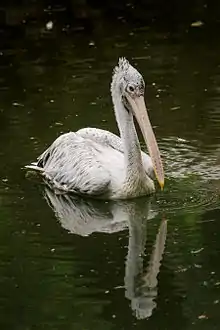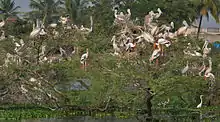Spot-billed pelican
The spot-billed pelican (Pelecanus philippensis) or grey pelican, is a member of the pelican family. It breeds in southern Asia from southern Pakistan across India east to Indonesia. It is a bird of large inland and coastal waters, especially large lakes. At a distance they are difficult to differentiate from other pelicans in the region although it is smaller but at close range the spots on the upper mandible, the lack of bright colours and the greyer plumage are distinctive. In some areas these birds nest in large colonies close to human habitations.
| Spot-billed pelican | |
|---|---|
 | |
| Scientific classification | |
| Kingdom: | Animalia |
| Phylum: | Chordata |
| Class: | Aves |
| Order: | Pelecaniformes |
| Family: | Pelecanidae |
| Genus: | Pelecanus |
| Species: | P. philippensis |
| Binomial name | |
| Pelecanus philippensis Gmelin, 1789 | |
Description
-_Adult_with_Immatures_at_nest_in_Garapadu%252C_AP_W_IMG_5283.jpg.webp)
The spot-billed pelican is a relatively small pelican but still a large bird. It is 125–152 cm (49–60 in) long and a weight of 4.1–6 kg (9.0–13.2 lb). It is mainly white, with a grey crest, hindneck and a brownish tail. The feathers on the hind neck are curly and form a greyish nape crest. The pouch is pink to purplish and has large pale spots, and is also spotted on the sides of the upper mandible. The tip of the bill (or nail) is yellow to orange. In breeding plumage, the skin at the base of the beak is dark and the orbital patch is pink. In flight they look not unlike the Dalmatian pelican but the tertials and inner secondaries are darker and a pale band runs along the greater coverts. The tail is rounder.[2]
The newly hatched young are covered in white down. They then moult into a greyish speckled plumage. The spots on the bill appear only after a year. The full adult breeding plumage appears in their third year.[3]
Habitat, distribution and status
_at_Garapadu%252C_AP_W_IMG_5369.jpg.webp)
The species is found to breed only in peninsular India, Sri Lanka and in Cambodia. A few birds from India are known to winter in the Gangetic plains but reports of its presence in many other parts of the region such as the Maldives, Pakistan and Bangladesh has been questioned.[2] The main habitat is in shallow lowland freshwaters. The spot-billed pelican is not migratory but are known to make local movements and are more widely distributed in the non-breeding season.

This species is a colonial breeder, often breeding in the company of other waterbirds. The nests are on low trees near wetlands and sometimes near human habitations. Many large breeding colonies have been recorded and several have disappeared over time. In June 1906, C E Rhenius visited a colony in Kundakulam in Tirunelveli district where the villages considered the birds semi-sacred.[4] The same colony was revisited in 1944, and was found to have about 10 nests of pelicans and nearly 200 nests of painted stork.[5]
The Sittang River in Burma was said by E W Oates to have "millions" of pelicans in 1877 and in 1929 E C Stuart Baker reported that they were still nesting in thousands along with greater adjutant storks:
The whole forest consisted of very large trees, but a portion, about one in twenty, was made up of wood-oil trees, gigantic fellows, 150 feet high and more, and with a smooth branchless trunk of 80 to 100 feet. These are the trees selected by the pelicans.
I was out that day till 3 p.m., continually moving, and must have walked at least twenty miles in various directions, but never from first to last was 1 out of sight of either a Pelican's or Adjutant's nest. From what I saw, and from what the Burmans told me, I compute the breeding-place of these birds to extend over an area about twenty miles long and five broad.
This colony was however reported by B E Smythies to have disappeared between the 1930s and the 1940s.[7]
Another colony was discovered in 1902 at a village called Buchupalle in the Cudappah district, where these pelicans nested along with painted storks during the month of March.[8] This colony was never traced again.[7] The Kolleru Lake colony was discovered by K K Neelakantan in 1946. Nearly 3000 pelicans nested in this colony at the time of discovery.[7][9] This colony however disappeared around 1975.[10][11][12]
Due to habitat loss and human disturbance, the spot-billed pelican's numbers have declined and many populations in Southeast Asia are now extinct.[13] The specific name refers to the Philippines, where the species was abundant in the early 1900s[3] but declined and become locally extinct in the 1960s.[14] The populations in southern India are thought to be on the rise.[15] Estimates suggest that increased protection has since enabled a recovery in their numbers and the status of the species was changed from vulnerable to near threatened in the 2007 IUCN Red List.[1]
Behaviour and ecology
_in_flight.jpg.webp)
_landing_with_nesting_material_at_nest_with_chicks_W2_IMG_2857.jpg.webp)
They are very silent although at their nests they can make hisses, grunts or snap their bills.[2] Some early descriptions of nesting colonies have claimed them to be distinctive in their silence but most have noted colonies as noisy.[7][16]
Like most other pelicans, it catches fish in its huge bill pouch while swimming at the surface. Unlike the great white pelican it does not form large feeding flocks and is usually found to fish singly or in small flocks. Groups may however sometimes line up and drive fish towards the shallows. When flying to their roosts or feeding areas, small groups fly in formation with steady flapping. During the hot part of the day, they often soar on thermals.[17] They may forage at night to some extent.[18]
The birds nest in colonies and the nest is a thick platform of twigs placed on a low tree. The breeding season varies from October to May.[2] In Tamil Nadu, the breeding season follows the onset of the northeast monsoon. The courtship display of the males involves a distention of the pouch with swinging motions of the head up and down followed by sideways swings followed by the head being held back over the back. Bill claps may also be produced during the head swaying movements.[19][20] The nests are usually built alongside other colonial waterbirds, particularly painted storks. Three to four chalky white eggs is the usual clutch. The eggs become dirty with age.[17] Eggs hatch in about 30–33 days. The young stay in or near the nest from three to five months.[19][21] In captivity the young are able to breed after two years.[22] Like other pelicans, they cool themselves using gular fluttering and panting.[23]
The trematode parasite Renicola pelecani was described from the kidneys of a specimen of a Sri Lankan spot-billed pelican that died at the London zoo.[24][25]
In culture
This species was once used by fishermen in parts of eastern Bengal as decoys for certain fish. These fishermen believed that an oily secretion from the bird attracted certain fish such as Colisa and Anabas.[26]
The propensity of these birds to nest close to human habitations has been noted from the time of T C Jerdon:
I have visited on Pelicanry in the Carnatic, where the Pelicans have (for ages I was told) built their rude nests, on rather low trees in the midst of a village, and seemed to care little for the close and constant proximity of human beings.
— Jerdon, 1864[26]
Several colonies have since been discovered and while many of these have vanished others have been protected and a few villages with nesting colonies have become popular tourist attractions. Well known villages with colonies include Kokrebellur, Koothankulam and Uppalapadu.[11][27]
References
- BirdLife International (2012). "Pelecanus philippensis". IUCN Red List of Threatened Species. 2012. Retrieved 26 November 2013.CS1 maint: ref=harv (link)
- Rasmussen, PC & JC Anderton (2005). Birds of South Asia: The Ripley Guide. Volume 2. Smithsonian Institution & Lynx Edicions. p. 49.
- McGregor, R C (1909). A manual of Philippine birds. Part 1. Bureau of Printing, Manila. pp. 208–210.
- Rhenius, C.E. (1907). "Pelicans breeding in India". J. Bombay Nat. Hist. Soc. 17 (3): 806–807.
- Webb-Peploe, CG (1945). "Notes on a few birds from the South of the Tinnevelly District". J. Bombay Nat. Hist. Soc. 45 (3): 425–426.
- Hume, AO (1890). The nests and eggs of Indian birds. Volume 3. R H Porter. p. 297.
- Gee, EP (1960). "The breeding of the Grey or Spottedbilled Pelican Pelecanus philippensis (Gmelin)". J. Bombay Nat. Hist. Soc. 57 (2): 245–251.
- Campbell, W.H. (1902). "Nesting of the Grey Pelican Pelecanus philippensis in the Cuddapah District, Madras Presidency". J. Bombay Nat. Hist. Soc. 14 (2): 401.
- Neelakantan, KK (1949). "A South Indian pelicanry". J. Bombay Nat. Hist. Soc. 48 (4): 656–666.
- Guttikar, S. N. (1978). "Lost pelicanry". J. Bombay Nat. Hist. Soc. 75: 482–484.
- Kannan V & R Manakadan (2005). "The status and distribution of Spot-billed Pelican Pelecanus philippensis in southern India" (PDF). Forktail. 21: 9–14.
- Nagulu, V & Ramana Rao, JV (1983). "Survey of south Indian pelicanries". J. Bombay Nat. Hist. Soc. 80 (1): 141–143.
- Crivelli, A; Schreiber, R (1984). "Status of the Pelecanidae". Biological Conservation. 30 (2): 147. doi:10.1016/0006-3207(84)90063-6.
- Van Weerd, Merlijn & J van der Ploeg (2004). "Surveys of wetlands and waterbirds in Cagayan valley, Luzon, Philippines" (PDF). Forktail. 20: 33–39.
- Gokula, V (2011). "Status and distribution of population and potential breeding and foraging sites of spot-billed pelican in Tamil Nadu, India". J. Sci. Trans. Environ. Technov. 5 (2): 59–69.
- Whistler, Hugh (1949). Popular handbook of Indian birds. Edition 4. Gurney and Jackson. pp. 489–491.
- Ali, Salim (1996). The Book of Indian Birds. Edition 12. BNHS & Oxford University Press. p. 66.
- Gokula, V. (2011). "Nocturnal foraging by Spot-billed Pelican in Tamil Nadu, India" (PDF). Marine Ornithology. 39: 267–268.
- Gokula, V (2011). "Breeding biology of the Spot-billed Pelican (Pelecanus philippensis) in Karaivetti Bird Sanctuary, Tamil Nadu, India". Chinese Birds. 2 (2): 101–108. doi:10.5122/cbirds.2011.0013.
- Gokula V (2011). "An ethogram of Spot-billed Pelican (Pelecanus philippensis)". Chinese Birds. 2 (4): 183–192. doi:10.5122/cbirds.2011.0030.
- Ali, S & Ripley, S D (1978). Handbook of the birds of India and Pakistan. 2 (2nd ed.). Oxford University Press. pp. 29–30.
- Das, RK (1991). "Assam: the main breeding ground of Spotbilled Pelican". Newsletter for Birdwatchers. 31 (11&12): 12–13.
- Bartholomew, GA; Robert C. Lasiewski & Eugene C. Crawford Jr. (1968). "Patterns of Panting and Gular Flutter in Cormorants, Pelicans, Owls, and Doves". The Condor. 70 (1): 31–34. doi:10.2307/1366506. JSTOR 1366506.
- Stunkard, Horace W. (1964). "Studies on the Trematode Genus Renicola: Observations on the Life-History, Specificity, and Systematic Position". Biological Bulletin. 126 (3): 467–489. doi:10.2307/1539314. JSTOR 1539314.
- Wright, C. A. (1954). "Trematodes of the genus Renicola from birds in British zoos, with descriptions of two new species". Journal of Zoology. 124: 51–61. doi:10.1111/j.1096-3642.1954.tb01477.x.
- Jerdon, TC (1864). The Birds of India. Volume 3. George Wyman & Co. pp. 858–860.
- Neginhal, S. G. (1977). "Discovery of a pelicanry in Karnataka". J. Bombay Nat. Hist. Soc. 74: 169–170.
External links
| Wikimedia Commons has media related to Pelecanus philippensis. |
